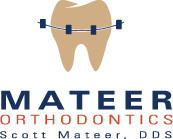Before our patients get their free consultation, they often call and ask if they are too old for orthodontic treatment. This is a great question, and the good news is this: Mateer Orthodontics treats patients of all ages! As long as your teeth are healthy, it is never too late to straighten them! In fact, taking action at any age can help prevent oral health problems from developing down the road. That is why we have treatment plans no matter your age or situation. Mateer Orthodontics can help you or your loved one achieve a smile that benefits dental health as much as it increases confidence.
Dr. Mateer has years of experience in the treatment of specific needs corresponding to patients whether young and old, and it all starts with the first conversation. Coming in for a free consultation means we can advise you on your own treatment options and give your kids a first orthodontic check-up, even if treatment for them is not needed.
As you consider treatment, take a look at the list below. You may be a good candidate if you suffer from the following:
- Crowded teeth
- Bad bite or malocclusion
- Gaps or spaces in between the teeth
- Abnormal jaw pain or pressure that is caused by crooked teeth
Perhaps you desire a healthier mouth and a more confident smile. A number of patients choose treatment for aesthetic reasons, but orthodontics does more than make a pretty smile and build confidence – it creates a healthier you! Plenty of research shows that your oral health has a great effect on your overall health. When you correct your oral health problems, you are making a lasting investment into your overall health.
Orthodontic treatment offers huge benefits at every age. Take a look below to learn more about the options available to you.
Orthodontics for Children
While there is no exact age for children to begin orthodontic treatment, the American Association of Orthodontists recommends visiting the orthodontist around age seven. By this age, most children have a mix of baby teeth and adult teeth, making it easier for the orthodontist to diagnose and correct tooth and jaw problems sooner and without surgery.
For parents, it is not always easy to know if your child may need orthodontic treatment. Parents should consult with their pediatric dentist regularly, but there are several warning signs you can look for in your child that may be indicative of childhood orthodontic problems such as the following:
- Early or late loss of baby teeth
- Finger or thumb sucking
- Grinding teeth
- Teeth that come together abnormally
- Breathing through the mouth or snoring
- Biting of cheeks
- Obvious overbite or underbite
- Difficulty chewing
For many of these cases and others not listed, early braces may be a good solution.
Orthodontics for Teens
The adolescent years are a crucial time for corrective treatment on the permanent teeth. By the age of thirteen, almost everyone has all of his or her permanent teeth, and a clear picture of an orthodontic situation has developed. This is the reason when you imagine someone with braces, you probably think of a teenager.
But as a result of heightened social anxiety, many teenagers dread wearing fixtures on their teeth. The good news is there are more options in orthodontic treatments today than ever before! Braces today come in a wide variety of styles and colors making life with braces much more comfortable and stylish. Yet, some teenagers are still hesitant. For that reason, we often recommend Invisalign.
Invisalign has many great features, but perhaps the most significant for teenagers is its virtual invisibility. A patient can wear it all day, and nobody will have the slightest idea that it is even there. As an added bonus, the trays are removable, so your teenager can eat the same foods as before!
Orthodontics for Adults
Did you know that plenty of adults are choosing orthodontic treatment? In fact, The American Association of Orthodontists reports that twenty-five percent of orthodontic patients are over 21 years of age.
Why are more and more adults today seeking treatment? Sometimes, parents choose to have orthodontic treatment when they see how confident it makes their children. Often, adult patients seek treatment for aesthetic reasons. Other times, adult patients want to do what is best for their oral health based on their dentist’s referral, as many oral health problems only get worse over time. No matter the reason for seeking adult braces, we have a solution that can help you reach your orthodontic goals and provide the smile you want.
Most adults deal with one or more of the following issues:
- Shifting and tilting invited by open space from missing teeth
- Gum disease (caused by crowded or uneven teeth that are difficult to clean)
- Worn teeth from misaligned bite
- Retreatment of orthodontic treatment from earlier in life (i.e. if you did not wear your retainer for the proper amount of time)
You may be surprised to know that there is a wide variety of orthodontic options for adults. During your initial consultation, we will do a thorough examination and discuss your personal situation with you. Our practice recognizes that adults have different needs than children and adolescents, and therefore, require a different level of attention and care. We will work with you to ensure that you receive the most appropriate treatment.
Mateer Orthodontics – A place for everyone
Dr. Mateer and his staff believe that establishing a relationship with each patient and family is an integral part of orthodontic treatment. Additionally, we strive to be an office comfortable for patients of all ages.
Mateer Orthodontics services patients all over Suffolk County including Commack, East Northport, Dix Hills and surrounding areas. It is our privilege to be part of your life-changing journey to a beautiful smile!
If you have questions or are looking for an orthodontics provider to help you and your family work toward better smiles, look no further.
Contact us today to schedule an appointment or to learn about the benefits of orthodontics at every age. We hope to see you soon!
































